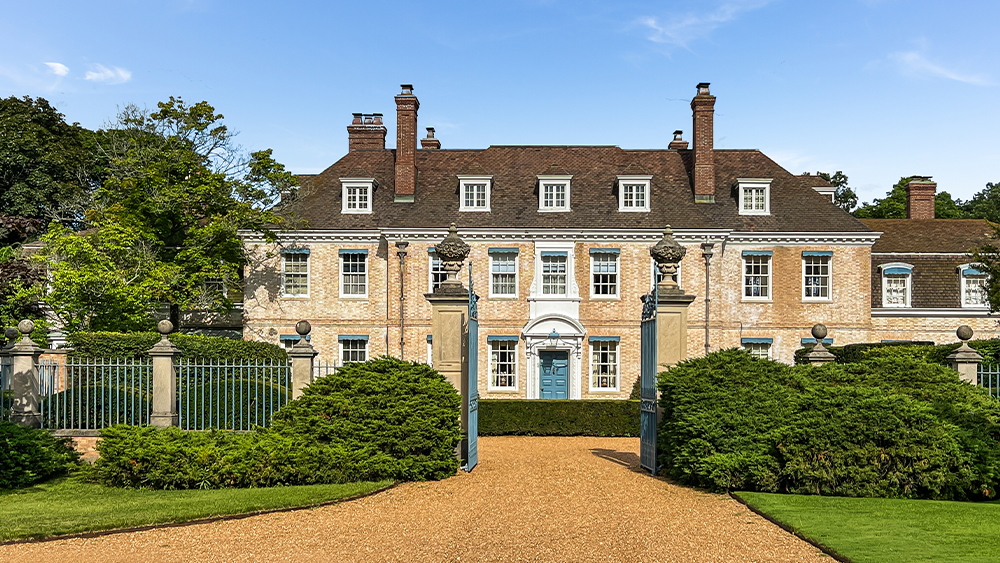Chicago may be the city that invented the skyscraper, but its surrounding towns and hamlets are home to some of the most spectacular traditionally designed estates in all of the nation. And few are more spectacular than Suffield House, a 1930s-era mansion in the affluent community of Lake Forest just north of the city on the shores of Lake Michigan. The property, which spans 15,000-square feet, is set on 5.
4 bucolic acres and is so regally designed and grandly laid-out that it could easily hold its own in, say, Newport, the Hamptons—or even on an episode of Downton Abbey . Suffield House was designed by architect David Adler, who’s responsible for some 200 of the most significant private residences and public gathering spaces in the Chicago area. For this home—originally built for Mrs.
J. Ogden “Lolita” Armour and now priced at $10. 1 million—Adler partnered with his sister, the noted designer Francis Adler Elkins who was instrumental in devising its overall aesthetic and furnishings.
The Armours, like many in the Midwest, owed their wealth to the industrialization of everyday products—in this case meat, having founded Armour and Company, once one of America’s largest meat-packing enterprises. The business thrived and the Armours purchased some 1,000 acres in Lake Forest—and Suffield House now stands on a small portion of this once vast landholding. “Mrs.
Armour named the home Suffield House after her birthplace in Connecticut, where her family had lived since Captain Jonathan Sledon bought 1,100 acres there in 1723,” explains Jenny Ames of Engel & Völkers Chicago, which has the listing . Suffield House is first encountered via a striking Neo-Georgian facade adorned with white-washed bricks with touches of pink highlighted throughout. According to Ames, Suffield House has been “preserved but not renovated,” with a pair of major modifications over its nearly 100 year history.
The first is the most notable and took place about 20 years ago and saw the addition of a large pool house to complement the original swimming pool, which was completed back in 1934. “The other major addition,” Ames says, “was to replace the vast (original) lawn with bent grass, which is primarily used for putting greens. ” It was a necessary move considering the home’s owners not only loved golf , but built a PGA-certified putting green on the property modeled after the 12th hole of the Augusta National Golf Club in Georgia.
“This is arguably the most famous golf hole in the world,” Ames explains. Spread over five total floors, the home—like Chicago itself—was architecturally and technologically ahead of its time. There’s an in-house elevator, for instance, which can fit a quartet of passengers along with central air conditioning, a rarity during the interwar period.
Suffield House, like most period estates, is divided into clear public and private spheres. The main level was clearly built for entertaining in mind, with a series of massive gathering spaces including a huge formal “great room” that would make the Dowager Countess proud. One floor higher, there’s the formal living room, library, solarium, dining room and massive gallery.
Bedrooms are clustered throughout the second and third floors, the latter also includes a second kitchen, living room and exercise room. Throughout the estate, Ames notes, noteworthy interior details abound—from priceless plaster ornaments, to centuries-old European paneling to 15th century Chinese oil paintings. “The stair hall is decorated with plaster vines, an aesthetic flourish which Adler adapted from the The Royal Fort in Gloucestershire,” she says.
Suffield House’s library features intricately carved cornices along with wooden blanks believed to have been salvaged from a schooner, while the formal, chandelier-capped dining room is anchored by a Baroque-styled mantelpiece and carved paneling by the notable 17th century Anglo-Dutch wood carver and sculptor Grinling Gibbons. His work can be found British landmarks such as Windsor Castle, St. Paul’s Cathedral and Hampton Court.
Suffield House’s elaborate design, while certainly impressive, is emblematic of the types of estates typically found in Lake Forest, a tranquil hamlet 30 miles from Chicago. “Lake Forest is known for its rich architectural history with numerous noteworthy homes built in the early 1900s by some of the nation’s wealthiest families,” Ames says. These include names like Marshall Field of the eponymous retailing empire, actor Robin Williams and television pundit Bill Maher.
“Lake Forest offers everything,” Ames continues, “a strong sense of community, public beaches, horse farms and lots of open land—all easily accessible to the city via Chicago’s Metra commuter rail system. ” Click here for additional images of Suffield House outside of Chicago:.
From: robbreport
URL: https://robbreport.com/shelter/homes-for-sale/chicago-area-estate-with-pro-putting-green-1234765280/
